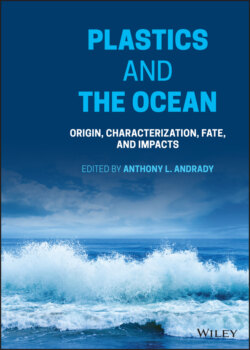Читать книгу Plastics and the Ocean - Группа авторов - Страница 15
Box 1.1 Thermoplastics and Thermosets
ОглавлениеAll plastics are polymers but not vice versa; plastics or thermoplastics include only those types of polymer that can be melted and re‐formed into different shapes repeatedly. Therefore, polymers such as tire rubber, polyurethane foam, or epoxy resin as well as cellulose or proteins, that do not melt on heating by virtue of their molecular architecture, are not thermoplastics but are thermosets. What is commonly described under “plastic debris” or “microplastics” in marine debris literature, however, often includes some thermosets such as epoxy resin, reinforced polyester (e.g., glass‐reinforced plastic (GRP)) and tire rubber particles. In this chapter, we will use the term “polymer” interchangeably with “plastic” for convenience of discussion.
Figure 1.1 Classification of plastic types commonly found in the marine environment.
Plastics owe their impressive success as a material to their unusual molecular structure that obtains a unique combination of advantages (Singh and Sharma 2008). Very long, chain‐like molecules in polymers result in strong attractive forces between them that allow for the development of unusual strength in the material. If the long‐chain molecules are flexible enough, they can also profusely entangle with each other, resulting in resistance to deformation, contributing to the strength of plastics. Thermoplastics can easily be formed into different shapes at relatively low temperatures to obtain lightweight (low density) products that are strong, transparent, bio‐inert, and gas‐impermeable, thereby making them ideal as packaging materials. Thermosets, especially polymer composites reinforced with fillers or carbon fibers, serve as a durable, high‐strength, and corrosion‐resistant material that allows a new degree of design freedom that is exploited in building design and transport applications. It is this combination of characteristics that impart the versatility of plastics in numerous applications. No wonder we now annually produce enough plastics that exceed the global biomass of human beings. Figure 1.1 shows the classification of common plastics in the marine environment.
Figure 1.2 shows a breakdown of the mix of plastic resins manufactured worldwide along with the main application sectors for different resin types. PE is the resin produced in the highest volume(~50%) followed by PP and PET. The figure shows that over 35% of resins produced are used in packaging where products are expected to have the shortest service life and are particularly likely to end up as urban or beach litter.
Figure 1.2 Left: Global plastic resin production (2015 data), Right: Percentage use of the production in different application sectors (miscellaneous categories not shown).
Source: Redrawn from data in Geyer et al. (2017)
